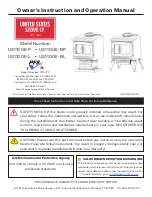
5
EN
G
L
ISH
Pellet features
The stove has been tested with all types of pellets present on the market. The used pellet must have the following features:
Diameter 6 mm;
Maximum length 35 mm;
Maximum humidity content 8
– 9 %;
100% wood. Total absence of additives.
1.1 % maximum ash residue
For good stove efficiency, we recommend the use of good quality pellets.
Pellets must be poured into the tank using a shovel and not directly from
the bag.
In order to recognise pellet of quality it is necessary that:
It is manufactured with constant diameter cylinders and it has a smooth and glossy surface;
There is not a lot of sawdust inside the packaging;
If the pellet is poured into a container of water it will sink if it is a quality pellet, while if it is not, it will tend to float;
The conditions of the quality certification and in particular the compliance with international Standards such as the EN14961-2, DIN 51731 and the
O-NORM M7135 are written in the packaging;
Packages are intact since pellets tend to absorb humidity. Humidity not only reduces the calorific value and increases exhaust flue gas, but swells
the product which could create problems in the stove.
International Standards must be respected for the manufacturing of pellets as in France, Austria, Germany and recently in some Eastern countries, also
complying with the EN14961-2, DIN 51731 and the O-NORM M7135 Standards in the production phase. These Standards establish the minimum values
in order to check pellet quality. In Italy there is no official Standard, but it is recommended to use pellets that respect the previously-mentioned Standards.
The use of poor pellets or pellets made of any other material can lead to damage of the stove functions and can also make the warranty null and
void and make the manufacturer exempt from all responsibility.
In order to guarantee combustion without problems the pellets must be kept in a dry place.
REQUISITES OF THE PLACE OF INSTALLATION
Positioning
The initial phase for the best installation of the stove is to determine its optimal location; the following data needs to be considered for this:
An external air vent can be made;
Possibility of creating a straight flue and possibly coaxial at the stove outlet;
Possibility of connecting the stove to an external vent;
Ease of access for cleaning the stove, the flue gas exhaust pipes and the flue.
The stove must be installed on a floor with suitable load capacity. If the existing building does not fulfil this requirement appropriate measures (e.g. load
distribution plate) must be taken.
Once the best location for the appliance is determined, it is possible to position the stove, following the indications below.
The minimum safety distance from flammable materials must be at least 200 mm from the sides and back of the stove.
Spaces around and above the stove
The figure below indicates the minimum measurements to respect when positioning the stove according to the walls.
REAR WALL
L
AT
E
R
A
L
W
A
L
L
L
AT
E
R
A
L
W
A
L
L
50 cm
50 cm
15 cm
Any shelves or suspending ceilings assembled above the stove must be at least 50 cm away from its upper part.
External air vent
While it is running the stove withdraws air from the environment in which it is installed
; It is essential that the air is restored through an external air
vent.
If the wall behind the stove is an outside wall, make a 15 cm diameter hole at 20 cm from the ground (as Fig. A).
Furniture and mobile objects must be positioned at least 20 cm from the stove sides walls; these objects must be moved when servicing the stove.
It is forbidden to hang shelves or build suspended ceilings above the stove at a distance measuring less than 50 cm.
Protect all structures that can catch fire from heat radiation.
The hole must be protected externally with a fixed grid.
Periodically ensure the grid is not obstructed by leaves or similar, thus blocking the air
passage.
If it is not possible to realise the air vent in the wall behind the stove, make the hole in a perimeter wall where the stove is installed.
If it not possible to realise the external air vent in the same room where the stove is installed, this hole can be made in an adjoining room as long as this
room communicates permanently, by means of a transit hole (15 cm minimum diameter).
The UNI 10683 Standard PROHIBITS the withdrawal of combustion air from garages, combustible material warehouses, or from businesses
where there is a fire hazard.
Содержание DEA PLUS
Страница 2: ...2...
Страница 4: ...4...
Страница 42: ...20...
Страница 62: ...20...
Страница 81: ...19 ESPA OL...
Страница 82: ...1 KLOVER SRL Via A Volta 8 37047 San Bonifacio VR internet www klover it e mail klover klover it...
















































